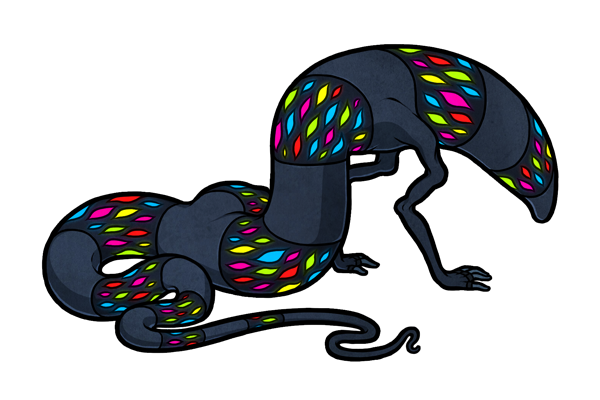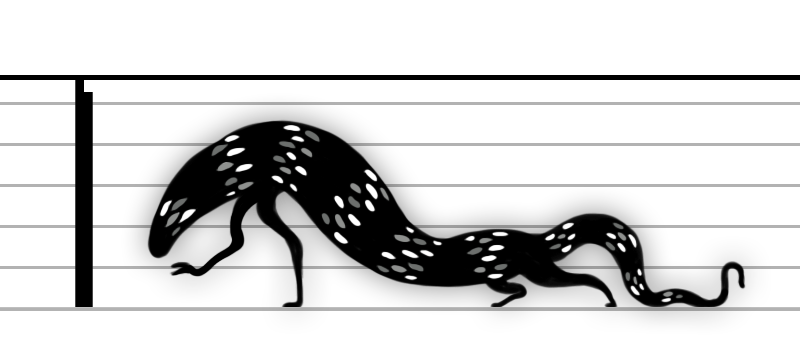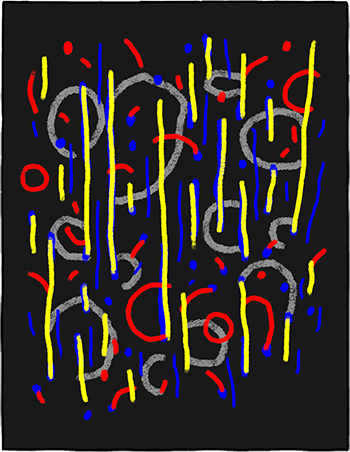

illidroni
the guides
prefix illi suffix droni
prer veritus
physical appearance
The illidroni /'ɪlədɹoʊni/ is a black-skinned stranger with a long, tubular body and skinny limbs. Its skin is rubbery in texture, feeling pleasantly soft and warm when touched while still remaining unmistakably inorganic. Its flesh is similarly composed and equally dark, with no moisture to speak of, while its body is filled with inky intestines that break down when pressed firmly or struck with any kind of blunt impact.
The illidroni's glowing eye markings are brightly colored and numerous, appearing down the length of its entire body. These eye markings are warmer than the rest of the illidroni's skin, but are unpleasantly warm in only a very small majority of individuals. An illidroni's markings constantly change color, flicker, or fade from one hue to the next in a wide variety of combinations. Each illidroni illuminates itself in a different pattern, with patterns changing at regular intervals.
The illidroni requires darkness to survive, and exposure to anything brighter than dim light causes its flesh to sear away into a black steam, dissolving away completely in less than three minutes. Its regenerative ability is all but nonexistent, meaning that even a brief exposure to light can prove fatal for this stranger. Although its skin and flesh are flexible, the illidroni is susceptible to both cuts, as well as any impact that damages its fragile internal organs.
It has no odor, and emits no sounds.
the absence of a voice.

environment and generation
The illidroni has no environmental requirements aside from its need for total darkness, and only appears in areas which experience a prolonged lack of light.𐐜 It seems to appear more frequently in unembellished corridors, empty warehouse rooms, and large but enclosed expanses of space. Vacant malls, unused floors of office buildings, or unfinished construction sites are all likely sites for an illidroni infestation. In contrast, it almost never appears in dilapidated, cluttered, or filthy locations.
During formation, the illidroni starts off as a swirling mass of shadows, and any amount of light causes this vapor to dissipate into nothing. This vapor eventually coalesces to form the illidroni's solid body, a process which can take anywhere from twenty minutes to two days (with some correlation in later stability; individuals that take longer to form tend to display a decrease in lifespan). The illidroni's eye markings are the last feature to form, and when they appear, they strobe in a flurrying kaleidoscope of lights and colors, which slow to the illidroni's more gradually shifting hues and patterns after several minutes.
When groups of illidroni form, they tend to generate in extremely close proximity, often coiled tightly side-by-side.
behaviour and effects
The illidroni possesses a leisurely disposition. The illidroni displays little interest in the world around it, and spends much of its time resting on its stomach or side, the tip of its tail flicking back and forth with a slow monotony as its eyes flash in patterns. It moves only to avoid light in its environment, but does not display any pain in response to fluorescence.
While it is not a strongly social stranger, the illidroni is not violent towards others of its strain, and groups of illidroni order themselves in looping, circular arrangements.
Certain sequences of eye illumination are accompanied by gestures similar to sign language, albeit with no correlation to existing languages. These do not seem to serve any communicative effect, with nearby illidroni displaying no response to these displays.
Despite its sensitivity to light, the illidroni is not negatively affected by either its own illumination nor that of its strain-mates. It does, however, display typical side-effects of light exposure when its glow is reflected back via the use of a mirror. When exposed to this stimulus, it becomes more restless in its behaviour, and it gestures both more frequently and with a shaking, palsied motion accompanied by a slight twitch of the neck, a behaviour not seen in response to other sources of light.
interactions with sensitives
The patterns and colors of the illidroni's eye markings have a strongly hypnotic effect on all who look at it, and those sensitives who encounter the illidroni become completely transfixed, staring for hours as the lights flicker and shift from hue to hue.
Exposure to the illidroni's lights causes blindness to those who look at them. This is a gradual process, with permanent effects. After one hour, those who stare at the illidroni develop blurred vision and near-sightedness, while after two hours, colors become difficult to distinguish, and brightness fades. By the fifth hour, victims lose all vision entirely. At this point, the illidroni tends to wander away, leaving its victims in a dazed stupor as the mesmeric effect fades. The initial symptoms, such as blurred vision, can be very slightly improved via the use of corrective lenses, but more significant symptoms lack a physical basis upon which to attempt treatment.
When a sensitive touches one of the illidroni's eyes, the eye's color fills the sensitive's vision.Ⱡ This touch appears to greatly increase the onset of blindness. The illidroni displays some vague irritation at this contact, and will move away from sensitives who choose to engage it in this manner. Otherwise, the illidroni remains indifferent to sensitives.
Ⱡ It was like looking at a faulty channel, first all red.
Due to the illidroni's mesmericΩ effect, violent encounters tend to be rare, as the illidroni's hypnotic influence completely overrides all destructive impulses in sensitives. When a sensitive does manage to attack the illidroni, the stranger's lights flash in wild, strobing patterns, which can trigger seizures in susceptible individuals, thus acting as a defense mechanism for this otherwise physically vulnerable strain.
Ω And in that red, something else; numbers, buildings, people – all of them, red.
Only colorblind sensitives display immunity from the illidroni's entrancement, although they still suffer side effects from looking at the illidroni. The illidroni appears harmed by the presence of blind sensitives, however, and tightens its body in a twisted position, reaching its hands from eye to eye as though attempting to cover its own vision. After several minutes in the presence of a blind sensitive, the illidroni begins to gouge its eye markings out, stopping only once all eyes have been excised, leaving it shuddering and vulnerable. Eyes removed from the illidroni's body never reform.
aging and death
As it ages, the illidroni's patterns grow both slower and less complex, until it displays only a single, near-white color. Once this occurs, it walks over to a corner or other secluded area, curling up as its eyes flicker off one-by-one. The illidroni dies the instant its last eye goes dark, and its corpse crumbles away to a fine, black powder. Nearby illidroni display a brief escalation in patterns before they return to normal, with no interest or regard for the pile of soot left behind, which grows smaller each day, disappearing completely in less than a week.





